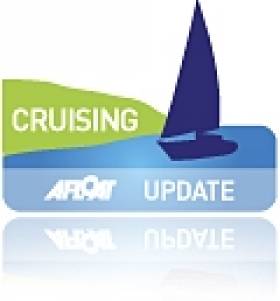Displaying items by tag: QUEST
Cruise Callers to Dun Laoghaire ‘Recalled’
#DUN LAOGHAIRE CRUISELINERS – The recent call of what is believed to be the world's smallest cruiseship the Quest (1991/1,180grt) to Dun Laoghaire Harbour as part of an initiative to develop this sector is by no means completely new to the harbour, writes Jehan Ashmore.
It was not until a decade ago that the last cruise callers were on the scene, albeit making infrequent visits and they also varied considerably in size. Among the callers was the famous 'Cunarder' Queen Elizabeth 2 or 'QE2', RCCL's Norway formerly French Line's France and Celebrity Cruise then brand new Constellation. Notably these large vessels all made anchorage calls in Dublin Bay.
Constellation made this call in 2002 as did the Sun Bay II which was also then recently launched into service and the cruiseships were making their debut season in European waters. They could not be so different, the 2,800 tonnes Sun Bay II with an 89 passenger capacity in complete contrast to the 90,000 tonnes Constellation with over 1,800 passengers.
The diminutive Sun Bay II was not too dissimilar to Noble Caledonia's Quest in terms of passenger capacity being slightly smaller with a capacity of 52. She was alongside Carlisle Pier where her guests were on a 9-night Garden themed cruise of UK and Ireland that included tours to Powerscourt and Mount Usher in Co. Wicklow.
On the call of Constellation she anchored relatively closer to the shore off Bulloch Harbour, compared to QE2 and Norway's calls and she presented an imposing and impressive sight.
In the case of the Norway, her passengers were ferried to the marina by unusually large tenders more akin to tank landing craft as they bow doors (click PHOTO). In fact they were so large that they could not be stowed on the lifeboat deck and instead located forward of the bridge where deck-mounted cranes were used for hoisting operations.
The practice of anchorage calls will continue as vessels of this size will remain too large to be accommodated in the harbour in the short term, though the Dun Laoghaire Harbour Company's 'masterplan' includes a proposed €18m new cruise terminal. They claim the terminal would be capable of handling the largest and most modern cruiseships in the world.
In the meantime the landing point for tenders to use a new tender dock facility was installed recently at the Traders Wharf, as distinct to the Carlisle Pier (site of proposed Diaspora Museum) where small to medium sized vessels are to berth.
A further three more calls are scheduled this season, including a return call next week of Quest and other vessels capable of carrying around 500 passengers. This figure is to rise considerably in May 2013, thanks mostly due in part to the massive Cunard Line flagship Queen Mary 2 (QM2). The 151,400 tonnes 'liner' can take over 2,600 passengers and 1,200 crew alone.
With the visit of QM2, this is to be her fist call to Dublin Bay, as she is still to be big even for Dublin Port to handle. Likewise the rivals across Dublin Bay in the Dublin Port Company are proposing as part of their masterplan to build a €30m dedicated cruise terminal. This facility would also be able to accommodate very large cruise callers.
It will be interesting to see how both completing ports progress and how they market themselves to the cruise sector industry, no doubt across the board. The giant ships look after large volumes which keep cruise prices down. As for the smaller boutique style of cruiseship operators, they can command higher prices by targeting the top end of the market and where they have higher-spending power at ports of call . The cruise industry overall is becoming increasingly more globalised where it was traditionally the preserve of the European and North American markets.
Arguably it is debatable if there should be two cruise terminals built as it reminiscent of the controversary during the '80's over the battle between which Dublin Bay port would be chosen for the site of a new single dedicated multi-user car-ferry terminal.
As it transpired the ferry service to Holyhead remains operating out of Dun Laoghaire Harbour, where a new terminal was built specifically to dock the revolutionary design of the HSS (High-speed Sea Service) fast craft catamaran car-ferry. Albeit in recent years the route's sailing frequency has reduced considerably. Under the last contract between Stena and the harbour company, this has led to considerably less revenue generated in harbour dues. The HSS Stena Explorer currently maintains only a single daily round-trip and only on a seasonal basis between April-September.
While at Dublin Port a multi-user ferry terminal was built but Stena Line did not immediately become part of the facility. It was not until 1995 that they set up an additional new service from Dublin Port to Holyhead. They use a second adjacent terminal that is currently served by two ferries on the company's second route to Wales.
Cruising Association Shocked by Fatal Shootings
Scott Adam was a member of the Cruising Association and was taking part in the round-the-world Blue Water Rally.
The Cruising Association is Britain's leading organisation for cruising sailors with members worldwide and works closely with government and other agencies to represent the interests of cruising yachtsmen including combating the menace of piracy.
"Our thoughts are with the family and friends of those who died", the statement ended.
Clipper Race Doc Goes Global on UK television
Six hour-long episodes capture every emotional twist and turn, high and low of the 35,000-mile race, following the participants in the ten-month-long challenge of a lifetime. Many of the crew had never set foot on a boat before beginning their pre-race training. From their first rookie steps to becoming a highly skilled ocean racer, the series charts their progress as they deal with the immense power of the world's oceans and everything Mother Nature can throw at them.
Dramatic footage captures a man overboard in the middle of the south Atlantic, dismastings, the devastating loss of a yacht and the terrifying experience of a yacht being rolled in the near hurricane conditions in the remote waters of the north Pacific. These heart-stopping scenes combine with the euphoria of race victories, personal voyages of discovery and the cementing of friendships that will last a lifetime.
As the race draws to its final, nail-biting conclusion and the emotional homecoming to a hero's welcome, Against the Tide captures the reactions of the racers after the event, to discover exactly how this unforgettable experience has changed their lives forever.
The international TV series, created by an award winning UK production team, is being snapped up by broadcasters around the world, including the Discovery Channel. The programmes will premiere on Discovery's UK free-to-air channel QUEST in a peak mid-week slot from next Wednesday, 2 March at 9pm.
TV series Producer John Nolan says, "The Clipper Race is a remarkable human adventure played out on the high seas. Our team had unrestricted access to the crews to follow their incredible journey around the world. The series provides a unique insight into the roller coaster of emotions and experiences as novice sailors from all walks of life discover how they cope when Mother Nature throws everything she's got at them.
"We're delighted with the programmes and have received an enthusiastic reception from broadcasters such as Discovery Channel. It will be seen by millions of viewers around the world."
The biennial race was established in 1996 by legendary yachtsman Sir Robin Knox-Johnston, who became the first person to sail solo, non-stop, around the world more than 40 years ago. He is chairman of the race which is almost full for the next event starting this summer and is already signing up crew for 2013.
Sir Robin says, "There is huge demand for this unique adventure which gives people of all ages and walks of life the opportunity to experience the thrill of ocean racing, Clipper provides extensive training and safety is our number one priority. So when our crews and their professional skippers encounter the dramatic challenges of the world's oceans, they can call upon their training and numerous safety drills to respond quickly and effectively. Taking part in the Clipper Round the World Yacht Race is a great personal achievement of which they can be justly proud and the television series captures it perfectly."
Watch Against the Tide on QUEST (Freeview channel 38, Sky channel 154, BT Vision channel 38, Virgin Media channel 179) from Wednesday 2 March at 2100 GMT.
The series has been produced by North One Television, one of Europe's biggest and most successful independent media companies. It is recognised as a global producer of world class entertainment, factual, digital, sport and live event programming and has won scores of awards for its shows. It is part of the ALL3MEDIA group. www.northonetv.com































































